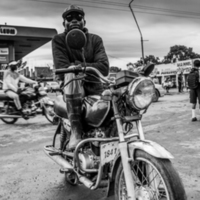
Danze: A Film by Yole!Africa
About the Collection
This collection documents the work of a community-based partnership between the Antislavery Usable Past project and Yole!Africa in Goma and Lubumbashi. The project is based on an archive of photography produced by the British missionary Alice Seeley Harris during her time in the Congo Free State in the late nineteenth and early twentieth century. The project has used the visual archive as a basis for working with young people to explore the history and legacies of colonialism during the time at which the Congo Free State was under the personal ownership of King Leopold II of Belgium.
Defining what the ‘antislavery usable past’ of these images is raises questions of power and representation. Who gets to decide? The writing of history is a powerful tool – who is included and excluded from the story, indeed, who gets to write it in the first place, is a reflection of the inequalities of the society within which that history is produced. Working with a colonial archive in Britain - a former centre of empire - raises issues about who gets to access history. For formerly colonised people their histories, or at least the portion of their histories relating to the colonial experience, are often found in the archives, museums, and art galleries of the former colonising power. Alice’s photographs, for example, eventually became part of the archive of the British and Foreign Antislavery Society, which subsequently became the present-day NGO Antislavery International. The archive is held at the Bodleian Library, University of Oxford. For people resident within the former spaces of empire, the physical impracticality of visiting the collection means a separation from the objects, documents, and images which represent their past.
This project offers a new way of working with colonial archives and in particular with the living communities whose past is present within these images of imperial exploitation. Working with these images within the communities that they represent is an important part of ceding control of the past. The aim is to make history useful and usable by telling the stories that matter to them. Returning photographs from Alice’s archive to the country in which it was produced allows Congolese people to decide for themselves what the usable past of the images might be. Developments in digitisation mean that an archive can be liberated from its physical location. With generous permission from Antislavery International, the Bodleian Library digitised the entire surviving collection of 509 photographs. Transformed from a rather unwieldy set of boxes into a hard drive, the collection gained the mobility necessary to work with partners in the Congo.
Through the critical and creative programme of education developed by Yole!Africa, Alice’s images have circulated among young people in Goma and Lubumbashi, who actively engage them when discussing their ideas about history, identity, and memory. Their powerful and insightful analysis of the images has given the photographs new meanings, which make them relevant for the present—not only in Congo, but also in former colonizing nations. Moreover, their artistic responses to the past demand that we reflect on the priorities motivating young people in formerly colonized countries and their critiques of contemporary society. Self-representation is central to the idea of freedom. Yole!Africa’s Executive Director Chérie Rivers Ndaliko has written about the power of self-representation stating that ‘When one’s story is one’s only possession of value, telling it becomes a matter of life and death… storytelling, more than taking arms, restores agency to those who have historically been the subject, indeed the collateral damage in this battle.’ With this in mind, we have actively sought the stories and opinions of those historically subjected to colonial domination, inviting them to amend historical records with their responses to colonial representations.
This collection contains a series of photographs which have been produced by young people in Goma and Lubumbashi in response to the original archive of Alice Seeley Harris images. They have been invited to recreate, contradict and recompose the images in relation to their own priorities. They explore themes of class, gender, race, sexuality, memory, labour, culture and history. These images formed part of an exhibition which took place at the Congo International Film Festival which was held at Yole!Africa in Goma in July 2018.
You can also view a film which has been created by Petna Katondolo Ndaliko which reflects on the relationship between history, memory and identity in relation to some of the issues raised by the Alice Seeley Harris archive and the histories it represents.
To access the original collection of photographs that this project engaged with you can search via the ‘Alternative Tag’ or you can click through the to ‘Alice Seeley Harris Archive’ and the ‘Congo Atrocity Lantern Lecture’.
A partner project was commissioned which explores similar issues in relation to the Congolese diaspora in London. You can access this material by clicking through to the collection ‘You Should Know Me: Photography and the Congolese Diaspora’.
The project has also collaborated closely with the Antislavery Knowledge Network, which is based at the University of Liverpool, and seeks community-led strategies for creative and heritage-based interventions in sub-Saharan Africa.
Copyright and takedown policy
Copyrights to all resources are retained by the Antislavery Usable Past project and Yole!Africa. The images and resources are available for educational and non-commercial use only. All efforts have been made to obtain copyright permission for materials featured on this site. If you are aware of instances where the rights holder(s) has not been given an appropriate credit, please let us know. If you hold the rights to any item(s) included in this resource and oppose to its use, please contact us to request its removal from the website.
Contact
Email: [email protected]
Acknowledgements
This project would not have been possible without the tireless work, energy, and commitment (both financial and intellectual) of Yole!Africa and its Artistic Director Petna Katondolo Ndaliko and Executive Director Dr. Chérie Rivers Ndaliko. Their support and enthusiasm has seen this project through its various phases and better partners could not have been asked for. Student ambassador Bernadette Vivuya has helped as both a participant and an organiser and has been a vital part of the project. We would like to thank Carlee Forbes (University of North Carolina) for her expertise on Congolese pre-colonial art and her help with the workshop in Goma. Our thanks also to Sammy Baloji and the team at PICHA! Gallery in Lubumbashi. Thanks to Dr Robert Burroughs (Leeds Beckett University) for offering important perspectives on Congolese resistance. Further thanks go to the Antislavery Knowledge Network, based at the University of Liverpool.
Further reading
Robert Burroughs, African testimony in the movement for Congo reform: The burden of proof (Abingdon: Routledge, 2018)
Marie Godin and Giorgia Doná, ‘“Refugee voices,” new social media and politics of representation: Young Congolese in the diaspora and beyond, Refuge, 32:1 (2016), pp. 60-71
Aubrey Graham, ‘One hundred years of suffering? “Humanitarian crisis photography” and self-representation in the Democratic Republic of the Congo’, Social Dynamics, 40:1 (2014), pp. 140-63
Osumaka Likaka, Naming colonialism: History and collective memory in the Congo, 1870-1960 (Wisconsin: University of Wisconsin Press, 2009)
Jane Lydon, ‘“Behold the tears”: Photography as colonial witness’, History of Photography, 34:3 (2010), pp. 234-50
Patrick Mudekereza and Allen F. Roberts, ‘Picha: The second Biennale of photography and video art Lubumbashi, Democratic Republic of the Congo October 2010’, African Arts, 44:3 (2011), pp. 68-75
Chérie Rivers Ndaliko, Necessary noise: Music, film, and charitable imperialism in the East of Congo (Oxford: Oxford University Press, 2016)
Mark Sealy, ‘Decolonising the camera: Photography in racial time’ (Unpublished PhD thesis, University of Durham, 2016)
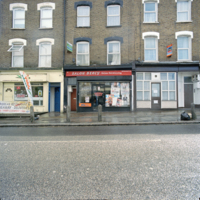
Bercy Salon
Letitia Kamaye: You Should Know Me
Artist’s Statement Kongo: You Should Know Me was my selfish way of learning more about my past, my ancestors through the images of my kinfolk. Unfortunately, the archive institutions I approached all asked for paperwork I could not supply; money I could not pay and questions I did not understand how to answer.
Only one missionary based in Ghent; the Sisters of Charity of Jesus and Mary, opened its doors and visual records to me and through them I was able to see a small percentage of the Congolese story before me. Though happy to have this access, I was not too overjoyed by everything I saw. There was a host of missing stories not recorded, stories that my family and friends families experienced. Chapters and verses missing from the identity of the Congolese narrative. Thus Kongo: You Should Know Me evolved to Kongo Archives.
Kongo Archives is extremely personal to me not merely because I am Congolese but also because there is a lot about my country I do not know and am searching for. I believe it is also something desperately needed, especially as our country’s political structure hangs in the global balance.
It’s a necessity even!
Culture; traditions; customs; language and pretty much everything has always been passed down orally through the stories in African customs, and now too many of those who did the passing down are fast passing away, taking with them all our history and rightful heritage. Taking away my rightful heritage, my story, my future and connection to a national identity.
It is a cliché to say, however Kongo Archives gives a voice to every Congolese person, travelling further than just those within the confines of the project. The archives is the stories of the past, the present and a storage unit where future stories can be placed when they become part of our inevitable past.
It [Kongo Archives] is here to topple the power structures of the single story of Congolese identity, working to reform the world’s understanding of, and have embedded notions questioned of a people whose stories and lives were second to the arrival of their colonial history and identity killers.
Bringing light to the stories which humanise the “so-called beasts from the dark continent” which continues till this day to suffer from decades of war and conflict whilst also being the wealthiest in natural minerals; culture and fight for peace one day.
Being Congolese I see our hidden presence in the “strangest” places, though this should not be a “strange” sight, this is the importance which representation brings! Change to people’s (and my own) opinions and views of those they are not well informed about. Kongo Archives will bring light to the multilayers of the Congolese people both residing in and out of The Motherland. It is important to have this representation to solidify the very absent Congolese presence outside of the Democratic Republic of Congo, in places such as London; Paris and Belgium as a positive display of unity; positive contribution and patriotism.
Kongo Archives aims to bring the Congolese heritage full circle through exposing the parts of our (Congolese) past and current state the world has and continues to fail to reveal. Breaking down the stereotypes of the poorest; “most dangerous place on earth to be a woman” to a country with a vast potential of peace; unconditional source of love and fight given the chance for change within its power structures.
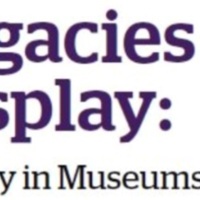
National Museum Afroperuano
The National Museum Afroperuano (or National Museum of Afro-Peruvian History) opened in 2009. Housed in the 'House of Thirteen Coins', in Lima, the museum is dedicated to acquiring, preserving and interpreting objects relating to African history in Peru.
The exhibitions begin by examining the arrival of Africans in Peru, via the Portuguese slave trade. The interpretation explores the process of enslavement and transportation alongside the nature of plantation work and the treatment of the enslaved by the Portuguese. A range of artefacts, artist representations and artefacts visually present these issues to visitors.
The exhibition examines the abolition of slavery in 1856 following the rise of Simon Bolivar and the independence of Peru. Objects and photographs then depict the influences of African culture in different aspects of Peruvian life, including music, dress, art and food.
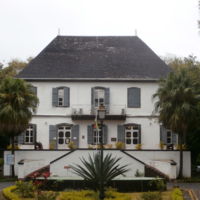
National History Museum
The National History Museum of Mauritius opened in 1948. It is housed in an French colonial villa built in 1772 that was formerly used as a military hospital, a naval museum and the Museum of Historical Souvenirs. It is managed by the Mauritius Museums Council, under the governance of the Ministry of Arts and Culture. The museum explores the social and cultural history of Mauritius; from its discovery by the Portuguese at the start of the sixteenth century, through its successive colonisations by the Dutch, French and British, up to the end of the nineteenth century.
The first floor of the museum exhibits the Dutch, French and Anglo-French wars. Each room explores a different era with artefacts from the period; these range from furniture and decorative arts to weapons, maritime equipment and ceramics.
On the second floor of the museum there is an exhibition dedicated to the British rule of Mauritius, from 1810 until 1968. The interpretation examines the transformation of Mauritius from a maritime economy to an agricultural one, with a key focus on the production of sugar. Alongside this is a discussion of the use of slavery and the development of the slave trade, indentured labour and Indian immigration. Artefacts here include agricultural tools, paintings and drawings depicting the changing landscape and the workforce, and archival documents.
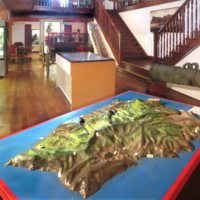
Museum of Saint Helena
The Museum of Saint Helena originated as a small natural history collection in 1854. Over the last 150 years it has moved three times before being officially opened in its current site in 2002 to mark the 500th anniversary of the island's discovery. It is housed in an eighteenth-century former power station in the island's capital, Jamestown. The museum explores the history of St Helena and it's position in the world. It has a large collection of physical artefacts supplemented by a digital archive of images, videos and audio.
The permanent exhibition offers a chronological view of Saint Helena's history, beginning with its geological development. The displays then explore the discovery of the island by European's, the role of the East India Company and migration. There is also a display about Napoleon Bonaparte's exile to Saint Helena.
Within the displays about colonisation and the East India Company are mentions of enslaved Africans brought to the island. Abolition and emancipation are also examined, as the interpretation moves on to explore the diverse make up of Saint Helena's population into the twentieth century. These displays are supported with artefacts and finds from recent archaeological digs on the island.
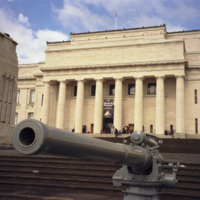
Auckland War Memorial Museum Tāmaki Paenga Hira
The Auckland War Memorial Museum Tāmaki Paenga Hira is one of New Zealand's oldest museum. Founded in 1852, the museum was formally inaugurated in its current site in 1929. It narrates the story of New Zealand, its place in the Pacific, and its people. The museum is also a war memorial for Auckland and houses one of New Zealand's three national heritage libraries.
The museum's collections incorporate military history, social history, local history, natural history and decorative arts. These are displayed through a range of permanent and temporary exhibitions, and on the museum's website. The exhibitions are themed and cover New Zealand's involvement in conflict, its natural history and ecological development and the arrival of Europeans. It also has three permanent galleries that explore its globally significant collection of Maori artefacts.
'He Taonga Māori' (or the Maori Court) is the gallery that greets visitors when they enter the museum's ground floor. This exhibition interprets the past, present and future of the Maori communities in New Zealand using over 1000 objects and a number of original, full-sized Maori buildings, including a meeting house. The collections are used to illustrate everyday Maori life, and range from carved wooden items, to woven textiles and tools. Oral testimonies from members of the Maori community are used to add a further layer of interpretation to the artefacts. A small area of the display discusses the Maori use of slavery, particularly with regards to captives from war.
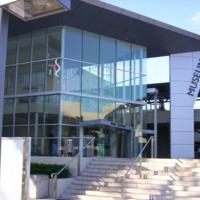
Queensland Museum
The Queensland Museum is a museum of natural history, science, human achievement and local interest that was founded by the Queensland Philosophical Society in 1862. Over the last century it has been housed in various sites, namely former colonial administrative buildings, until the local government had a purpose built site constructed for the museum on Brisbane's South Bank in 1986. Funded by the Queensland Government, the Queensland Museum Trust operates a number of sites in addition to the Queensland Museum. These include the Science Centre, the Queensland Museum of Tropics and the Workshops Rail Museum.
The museum's aim is to connect its visitors to Queensland the place, the people and the region's position in the world through artefacts, interactives and events. There are over one million items in its collections. The permanent exhibitions look at Queensland's ecological and social development.
In 'Histories of Queensland,' the exhibition explores the theme of migration to the area. As well as examining the European migration to the area during the eighteenth and nineteenth centuries, the displays discuss the role of indentured labourers from the South Sea Islands. These people were forcibly transported from their homes to work in Queensland's sugar industry. The display informs visitors about the hardships faced by these individuals and the negative legacies this brutal enslavement inflicted on the South Sea Islands from the nineteenth century until today.
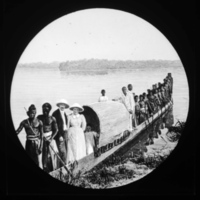
Christian Missionaries
A Christian missionary party crossing the Aruwimi river in the Aruwimi Welle zone of the Belgian Congo. This image (Neg. 102) formed part of the Harris Lantern Slide Collection. Under King Leopold II the Congo Free State used mass forced labour to extract rubber from the jungle for the European market. As consumer demand grew King Leopold II's private army - the Force Publique - used violent means to coerce the population into meeting quotas, including murder, mutilation, rape, village burning, starvation and hostage taking. Alice Seeley Harris and her husband Reverend John H. Harris were missionaries in the Congo Free State from the late 1890s. Alice produced a collection of images documenting the horrific abuses of the African rubber labourers. Her photographs are considered to be an important development in the history of humanitarian campaigning. The images were used in a number of publications. The Harrises also used the photographs to develop the Congo Atrocity Lantern Lecture which toured Britain and the the USA raising awareness of the issue of colonial abuses under King Leopold II's regime. Source: Antislavery International and Panos Pictures.
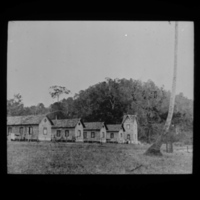
European-Style Houses
Unknown. This image formed part of the Harris Lantern Slide Collection. Under King Leopold II the Congo Free State used mass forced labour to extract rubber from the jungle for the European market. As consumer demand grew King Leopold II's private army - the Force Publique - used violent means to coerce the population into meeting quotas, including murder, mutilation, rape, village burning, starvation and hostage taking. Alice Seeley Harris and her husband Reverend John H. Harris were missionaries in the Congo Free State from the late 1890s. Alice produced a collection of images documenting the horrific abuses of the African rubber labourers. Her photographs are considered to be an important development in the history of humanitarian campaigning. The images were used in a number of publications. The Harrises also used the photographs to develop the Congo Atrocity Lantern Lecture which toured Britain and the the USA raising awareness of the issue of colonial abuses under King Leopold II's regime. Source: Antislavery International.
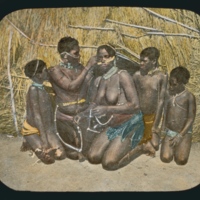
Group of African Women
Unknown. Group of African women.This image formed part of the Harris Lantern Slide Collection. Under King Leopold II the Congo Free State used mass forced labour to extract rubber from the jungle for the European market. As consumer demand grew King Leopold II's private army - the Force Publique - used violent means to coerce the population into meeting quotas, including murder, mutilation, rape, village burning, starvation and hostage taking. Alice Seeley Harris and her husband Reverend John H. Harris were missionaries in the Congo Free State from the late 1890s. Alice produced a collection of images documenting the horrific abuses of the African rubber labourers. Her photographs are considered to be an important development in the history of humanitarian campaigning. The images were used in a number of publications. The Harrises also used the photographs to develop the Congo Atrocity Lantern Lecture which toured Britain and the the USA raising awareness of the issue of colonial abuses under King Leopold II's regime. Source: Antislavery International
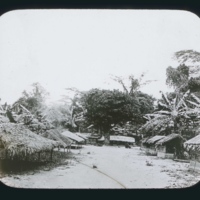
Village in the Forest
Unknown.This photograph formed part of the Harris Lantern Slide Collection. Under King Leopold II the Congo Free State used mass forced labour to extract rubber from the jungle for the European market. As consumer demand grew King Leopold II's private army - the Force Publique - used violent means to coerce the population into meeting quotas, including murder, mutilation, rape, village burning, starvation and hostage taking. Alice Seeley Harris and her husband Reverend John H. Harris were missionaries in the Congo Free State from the late 1890s. Alice produced a collection of images documenting the horrific abuses of the African rubber labourers. Her photographs are considered to be an important development in the history of humanitarian campaigning. The images were used in a number of publications. The Harrises also used the photographs to develop the Congo Atrocity Lantern Lecture which toured Britain and the the USA raising awareness of the issue of colonial abuses under King Leopold II's regime. Source: Antislavery International.
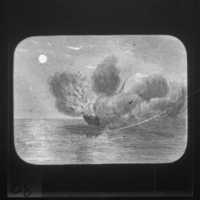
Image of a Ship
Unknown. This image formed part of the Harris Lantern Slide Collection. Under King Leopold II the Congo Free State used mass forced labour to extract rubber from the jungle for the European market. As consumer demand grew King Leopold II's private army - the Force Publique - used violent means to coerce the population into meeting quotas, including murder, mutilation, rape, village burning, starvation and hostage taking. Alice Seeley Harris and her husband Reverend John H. Harris were missionaries in the Congo Free State from the late 1890s. Alice produced a collection of images documenting the horrific abuses of the African rubber labourers. Her photographs are considered to be an important development in the history of humanitarian campaigning. The images were used in a number of publications. The Harrises also used the photographs to develop the Congo Atrocity Lantern Lecture which toured Britain and the the USA raising awareness of the issue of colonial abuses under King Leopold II's regime. Source: Antislavery International.
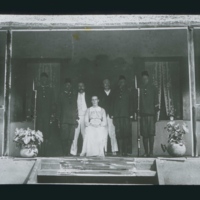
Alice Seeley Harris, John Harris and Rev. Edgar Stannard
Reverend John H. Harris, Alice Seeley Harris and Reverend Edgar Stannard of the Congo Balolo Mission under guard at Baringa. This image formed part of the Harris Lantern Slide Collection. Under King Leopold II the Congo Free State used mass forced labour to extract rubber from the jungle for the European market. As consumer demand grew King Leopold II's private army - the Force Publique - used violent means to coerce the population into meeting quotas, including murder, mutilation, rape, village burning, starvation and hostage taking. Alice Seeley Harris and her husband Reverend John H. Harris were missionaries in the Congo Free State from the late 1890s. Alice produced a collection of images documenting the horrific abuses of the African rubber labourers. Her photographs are considered to be an important development in the history of humanitarian campaigning. The images were used in a number of publications. The Harrises also used the photographs to develop the Congo Atrocity Lantern Lecture which toured Britain and the the USA raising awareness of the issue of colonial abuses under King Leopold II's regime. Source: Antislavery International.
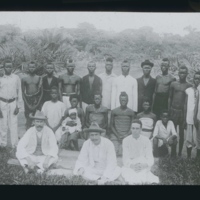
John Harris, Alice Seeley Harris, Rev. Edgar Stannard with the Congolese
The Reverend John Harris (left front) and Alice Seeley Harris (right front), Reverend Edgar Stannard (centre) and a group of Congolese people. This photograph (Neg. 106) formed part of the Harris Lantern Slide Collection. Under King Leopold II the Congo Free State used mass forced labour to extract rubber from the jungle for the European market. As consumer demand grew King Leopold II's private army - the Force Publique - used violent means to coerce the population into meeting quotas, including murder, mutilation, rape, village burning, starvation and hostage taking. Alice Seeley Harris and her husband Reverend John H. Harris were missionaries in the Congo Free State from the late 1890s. Alice produced a collection of images documenting the horrific abuses of the African rubber labourers. Her photographs are considered to be an important development in the history of humanitarian campaigning. The images were used in a number of publications. The Harrises also used the photographs to develop the Congo Atrocity Lantern Lecture which toured Britain and the the USA raising awareness of the issue of colonial abuses under King Leopold II's regime. Source: Antislavery International.
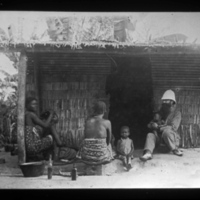
Missionary and African Women
Unknown. This image formed part of the Harris Lantern Slide Collection and was used in the Harris Lantern Lecture No 2. Under King Leopold II the Congo Free State used mass forced labour to extract rubber from the jungle for the European market. As consumer demand grew King Leopold II's private army - the Force Publique - used violent means to coerce the population into meeting quotas, including murder, mutilation, rape, village burning, starvation and hostage taking. Alice Seeley Harris and her husband Reverend John H. Harris were missionaries in the Congo Free State from the late 1890s. Alice produced a collection of images documenting the horrific abuses of the African rubber labourers. Her photographs are considered to be an important development in the history of humanitarian campaigning. The images were used in a number of publications. The Harrises also used the photographs to develop the Congo Atrocity Lantern Lecture which toured Britain and the the USA raising awareness of the issue of colonial abuses under King Leopold II's regime. Source: Antislavery International.
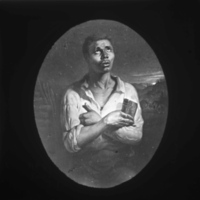
Praying Man
Unknown. This photograph formed part of the Harris Lantern Slide Collection. Under King Leopold II the Congo Free State used mass forced labour to extract rubber from the jungle for the European market. As consumer demand grew King Leopold II's private army - the Force Publique - used violent means to coerce the population into meeting quotas, including murder, mutilation, rape, village burning, starvation and hostage taking. Alice Seeley Harris and her husband Reverend John H. Harris were missionaries in the Congo Free State from the late 1890s. Alice produced a collection of images documenting the horrific abuses of the African rubber labourers. Her photographs are considered to be an important development in the history of humanitarian campaigning. The images were used in a number of publications. The Harrises also used the photographs to develop the Congo Atrocity Lantern Lecture which toured Britain and the the USA raising awareness of the issue of colonial abuses under King Leopold II's regime.Source: Antislavery International.
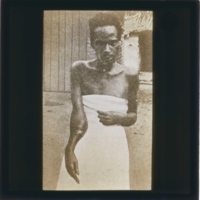
Photo of African Man, taken by W.D. Armstrong
Unknown. This photograph was taken by W. D. Armstrong.This image formed part of the Harris Lantern Slide Collection. Under King Leopold II the Congo Free State used mass forced labour to extract rubber from the jungle for the European market. As consumer demand grew King Leopold II's private army - the Force Publique - used violent means to coerce the population into meeting quotas, including murder, mutilation, rape, village burning, starvation and hostage taking. Alice Seeley Harris and her husband Reverend John H. Harris were missionaries in the Congo Free State from the late 1890s. Alice produced a collection of images documenting the horrific abuses of the African rubber labourers. Her photographs are considered to be an important development in the history of humanitarian campaigning. The images were used in a number of publications. The Harrises also used the photographs to develop the Congo Atrocity Lantern Lecture which toured Britain and the the USA raising awareness of the issue of colonial abuses under King Leopold II's regime.Source: Antislavery International.
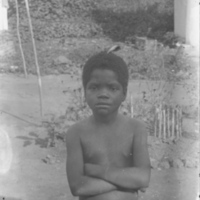
African Child
African child. This image formed part of the Harris Lantern Slide Collection. Under King Leopold II the Congo Free State used mass forced labour to extract rubber from the jungle for the European market. As consumer demand grew King Leopold II's private army - the Force Publique - used violent means to coerce the population into meeting quotas, including murder, mutilation, rape, village burning, starvation and hostage taking. Alice Seeley Harris and her husband Reverend John H. Harris were missionaries in the Congo Free State from the late 1890s. Alice produced a collection of images documenting the horrific abuses of the African rubber labourers. Her photographs are considered to be an important development in the history of humanitarian campaigning. The images were used in a number of publications. The Harrises also used the photographs to develop the Congo Atrocity Lantern Lecture which toured Britain and the the USA raising awareness of the issue of colonial abuses under King Leopold II's regime. Source: Antislavery International.
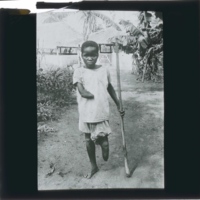
A Young Boy
A young boy (Impongi) with a severed hand and foot, mutilated by sentries after his village failed to meet its rubber quota. He was a witness before King Leopold II's Commission of Enquiry which was an unsuccessful attempt to refute Roger Casement's damning report to the British government on human rights abuses in the Congo Free State. This image formed part of the Harris Lantern Slide Collection. Under King Leopold II the Congo Free State used mass forced labour to extract rubber from the jungle for the European market. As consumer demand grew King Leopold II's private army - the Force Publique - used violent means to coerce the population into meeting quotas, including murder, mutilation, rape, village burning, starvation and hostage taking. Alice Seeley Harris and her husband Reverend John H. Harris were missionaries in the Congo Free State from the late 1890s. Alice produced a collection of images documenting the horrific abuses of the African rubber labourers. Her photographs are considered to be an important development in the history of humanitarian campaigning. The images were used in a number of publications. The Harrises also used the photographs to develop the Congo Atrocity Lantern Lecture which toured Britain and the the USA raising awareness of the issue of colonial abuses under King Leopold II's regime. Source: Antislavery International and Panos Pictures.
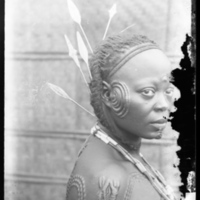
Young African Woman
Two descriptions exist for this image. The first is taken from the original photograph held at the Bodleian Library in Oxford. It reads 'An Ikelemba woman with tribal mark.' The second is taken from Antislavery International website's and reads 'Ngombe woman from the Bangalla region of the Upper Congo. The face cicatrisation is called 'the rasp'. Cicatrisation was a common practice in this region. See John H. Harris, Dawn in Darkest Africa (London: Smith, Elder & Co, 1912).' This photograph formed part of the Harris Lantern Slide Collection and was used in the Harris Lecture No.2. This image formed part of the Harris Lantern Slide Collection. Under King Leopold II the Congo Free State used mass forced labour to extract rubber from the jungle for the European market. As consumer demand grew King Leopold II's private army - the Force Publique - used violent means to coerce the population into meeting quotas, including murder, mutilation, rape, village burning, starvation and hostage taking. Alice Seeley Harris and her husband Reverend John H. Harris were missionaries in the Congo Free State from the late 1890s. Alice produced a collection of images documenting the horrific abuses of the African rubber labourers. Her photographs are considered to be an important development in the history of humanitarian campaigning. The images were used in a number of publications. The Harrises also used the photographs to develop the Congo Atrocity Lantern Lecture which toured Britain and the the USA raising awareness of the issue of colonial abuses under King Leopold II's regime. Source: Antislavery International.